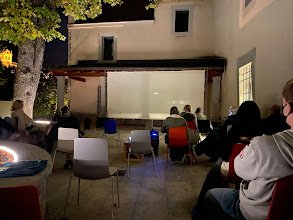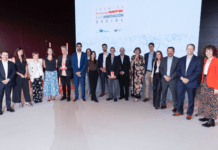The outdoors screening at Casa de La Moneda on the 17th of September was one of the great opening scenes for this delightfully well curated festival that serves as a showcase of the cultural scene in Segovia. The area was cozy and homey, with few chairs and blankets offered for the cold. The film, Es Gilt Das Gesprochene Wort (literally translated to The Spoken Word Counts), is relatively new, and talks about an unexpected but charming story: that of a kurdish gigoló, Baran, struggling to make ends meet, and a German pilot recently diagnosed with cancer, Marion.
In the midst of her own personal crisis handling her illness and her recent separation from her husband, Marion agrees to marry Baran for convenience in Germany, where he can pursue a better life. Throughout the film Baran’s always helped by Marion, who even gets him his first apartment and job. But it is also clear that they do not love each other and soon enough they start drifting apart, culminating in Baran going back to work at his home country, in the same industry Marion introduced him to, but with a much higher position.
As a classical musician, I was delighted to find that the film used many compositions by Schubert, the Austrian composer known for the transition from Classicism to Romanticism. Take as an example his most famous Ständchen, which isn’t but a lover’s serenade. Interestingly enough, and maybe considered by the director of the movie, Ilker Çatak, this piece of his was one of the last the composer wrote before passing, and which remains one of his most famous masterpieces.
The film’s format also helps the viewer understand about life and love, two things that never stay still – if not necessarily progress forward along the way. In essence, the film tells us very clearly that it is not a love story, but that doesn’t stop it from being a more existentialist masterpiece in its own right. Even though the plot of the movie is completely new, both the topics explored (tempus fugit, as the main characters are continuously evolving) and the three movement structure make it, in a way, a very classical film, that very soberly and elegantly tells an immigrant’s story.
The film and the festival from the perspective of Carlos Redondo, manager at IE Creativity Center

Q: What was the idea or motivation behind the festival and showing this film in particular?
A: Our main goal was to offer a festival that was of interest to the youth, revolving around the feeling that the word home (casa) evokes. On the other hand, the films we are offering are all curated and are meant to represent diversity and variety of people, in this case with a migrant protagonist, engaging and disengaging with his own new environment.
Q: How would you classify the film: as a romance, a tragedy…?
A: It is definitely the story of the main characters’ voyage into themselves, not as a couple but as separate units. They go through radical changes in their cultural genome as well as culture shock, therefore it is a drama from the perspective of embracing the unknown.
Q:If you were asked, to what other piece would you compare the film?
A: In the less mainstream world of film, there’s a Spanish stop motion animator called Coke Riobóo, who some years ago produced El viaje de Said (2007), about a Moroccan boy who migrates to Spain in the hopes of finding a better life. Otherwise, I would have to compare it to the original Odyssey.
Q: What purpose do you think the festival accomplishes, regarding culture in Segovia?
A: Our purpose is to add together both universes that converge in Segovia, IE and the city itself. I think these aren’t as opposite as it’s often thought; overcoming the challenge of globality isn’t about language, but about creating a dialogue through art.
Q: Is there anything you can reveal about the next edition of CASAFAF?
A: Yes, we will be focusing on female directors’ works so stay tuned to our instagram @ie.creativitycenter








